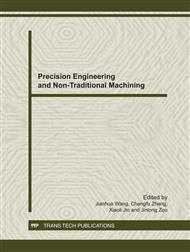p.130
p.135
p.140
p.144
p.149
p.158
p.163
p.169
p.174
A Kind of Mathematical Solution of Optimization for Turning
Abstract:
As a base of optimization of metal cutting, a new method of solution of optimization for single pass turning is proposed in this paper. There are three parts for this new method. Firstly, the optimal point must exist on the boundary of the feasible domain of the cutting conditions. Secondly, it is easy to add the processing of determining the boundary of feasible domain as new constraints. Thirdly, the local optimal point on every piece of line or curve of the boundary can be calculated, and finally the minimum of those local optimal points is the final optimal point. There are no local optimal points on the curves of constraints Tmin and Tmax except the intersection points. In addition, the trend of the objective function is affected by the rate . It is helpful to calculate the optimal point by computer. This approach provides a basic research on the affection of the statistics characteristic of the empirical functions used in this case.
Info:
Periodical:
Pages:
149-157
Citation:
Online since:
November 2011
Authors:
Keywords:
Price:
Сopyright:
© 2012 Trans Tech Publications Ltd. All Rights Reserved
Share:
Citation:


